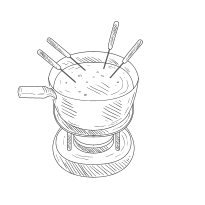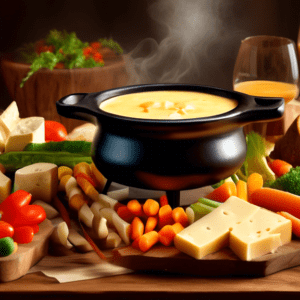What is Cheese Fondue?
Cheese fondue! The mere mention of it conjures images of cozy nights, crackling fireplaces, and convivial gatherings. Originating from Switzerland, this dish is not just about the food; it’s about the experience. Imagine dipping crusty bread into a bubbling pot of molten cheese, the aroma filling the air, and laughter echoing around the table. That’s the magic of cheese fondue.
A Brief History of Cheese Fondue
Fondue, meaning melted in French, has its roots in the Swiss Alps. In the cold winter months, Swiss farmers, isolated by snow and limited in fresh produce, turned to readily available ingredients: aged cheese, wine, and bread. These humble ingredients, when combined and heated, created a nourishing and comforting meal.
Over time, fondue evolved from a peasant dish into a national treasure. In the 1930s, the Swiss Cheese Union cleverly promoted fondue as a national dish, boosting cheese consumption. By the 1960s and 70s, fondue parties were all the rage, solidifying fondue’s place as a symbol of warmth and good times.
The Perfect Cheese Fondue: A Step-by-Step Guide
Creating an unforgettable cheese fondue experience is easier than you might think. Here’s a comprehensive guide, packed with tips and tricks, to help you become a fondue master.
Choosing Your Cheese
The soul of any great fondue is, of course, the cheese. While the classic Swiss cheeses, Gruyère and Emmental, are traditional choices, don’t be afraid to experiment! Here are some cheese options and what they bring to the fondue pot:
- Gruyère: Nutty, slightly sweet, and melts beautifully.
- Emmental: Adds a milder flavor and helps create a smooth, creamy texture.
- Fontina: Imparts a subtle earthiness and enhances the fondue’s creaminess.
- Comté: Known for its complex, fruity notes and excellent melting qualities.
- Appenzeller: Offers a more robust, pungent flavor for adventurous palates.
Pro Tip: Use a combination of cheeses for greater depth of flavor. Grate the cheese beforehand for even melting.
Essential Equipment
Having the right tools makes all the difference in fondue preparation and enjoyment:
- Fondue Pot: A heavy-bottomed pot (ceramic, enamelled cast iron, or stainless steel) is essential for even heat distribution, preventing the cheese from scorching.
- Fondue Burner: A small burner (usually fueled by gel or liquid fuel) sits beneath the fondue pot, keeping the cheese at the perfect dipping consistency.
- Fondue Forks: These long-stemmed forks have two or three prongs to securely hold bread and other dippers.
- Cutting Board and Sharp Knife: For prepping your bread and other dipping ingredients.
- Wooden Spoon: For stirring the cheese mixture as it melts.
The Ingredients:
This recipe is for a classic Swiss cheese fondue. Feel free to adjust the quantities based on your preferences and the number of guests.
- 1 clove garlic, halved
- 1 cup (240 ml) dry white wine (such as Sauvignon Blanc or Pinot Grigio)
- 1 tablespoon cornstarch
- 1/4 teaspoon freshly grated nutmeg
- 1/4 teaspoon black pepper
- 1/8 teaspoon cayenne pepper (optional, for a touch of heat)
- 12 ounces Gruyère cheese, shredded
- 12 ounces Emmental cheese, shredded
Step-by-Step Instructions
- Prep the Pot: Rub the inside of the fondue pot with the cut side of the garlic clove. This adds a subtle garlic flavor to the fondue.
- Heat the Wine: Pour the wine into the fondue pot and heat over medium heat. Let the wine come to a simmer, but do not boil.
- Combine Cornstarch and Spices: In a small bowl, whisk together the cornstarch, nutmeg, black pepper, and cayenne pepper (if using).
- Gradual Cheese Addition: Add the shredded cheese to the simmering wine in small handfuls, stirring constantly with a wooden spoon. Ensure each handful is fully melted before adding the next. This slow melting process is crucial for a smooth, lump-free fondue.
- Incorporate Cornstarch Mixture: Once all the cheese is melted, gradually whisk in the cornstarch mixture. This will help to thicken the fondue and prevent separation.
- Final Simmer: Continue to cook the fondue over low heat for a few minutes, stirring occasionally, until it reaches your desired consistency. It should be smooth, creamy, and bubbly.
- Transfer to the Burner: Carefully transfer the fondue pot to the fondue burner. Light the burner and adjust the flame as needed to maintain a gentle simmer.
- Time to Dip! Surround your fondue pot with a variety of dipping items and enjoy!
Beyond the Bread: Exploring Fondue Dippers
While crusty bread is a fondue staple, there’s a world of delicious dippers waiting to be explored:
Breads and Bread-Like Delights:
- Baguettes, cubed
- Sourdough bread, cubed
- Rye bread, cubed
- Pretzel bites
- Crostini
Vegetables:
- Broccoli florets
- Cauliflower florets
- Brussels sprouts, halved
- Bell peppers, cut into bite-sized pieces
- Cherry tomatoes
- Baby potatoes, boiled
Proteins:
- Cooked shrimp
- Cooked chicken, cubed
- Cocktail sausages
- Meatballs
Other Delicious Dippers:
- Apples, sliced
- Pears, sliced
- Grapes
- Dried apricots
- Roasted potatoes
Pro Tip: Make sure your dipping items are cut into bite-sized pieces for easy dipping and to prevent forks from falling into the fondue pot.
Troubleshooting Your Cheese Fondue
Even experienced fondue chefs encounter a mishap or two. Here are solutions to common fondue problems:
Fondue Too Thick:
Add a tablespoon or two of warmed wine to the fondue and stir until it reaches the desired consistency.
Fondue Too Thin:
In a small bowl, whisk together a tablespoon of cornstarch with two tablespoons of wine. Slowly whisk this mixture into the fondue and cook, stirring constantly, until thickened.
Fondue is Separating:
This usually happens when the fondue gets too hot. Remove the fondue pot from the heat immediately. Add a teaspoon of lemon juice and whisk vigorously. The lemon juice helps to re-emulsify the cheese.
Fondue Etiquette: A Guide to Shared Indulgence
Fondue is more than just a meal; it’s a social experience. Here are a few etiquette tips to ensure a harmonious gathering:
- Swirl, Don’t Spear: When dipping, gently swirl your bread or other dippers in the cheese, rather than spearing them. This ensures even coating and prevents dripping.
- Double Dipping Dilemmas: To avoid the double-dipping taboo, use a clean portion of your dipping item for each dip.
- Lost and Found (in the Fondue): Tradition dictates that whoever loses their bread in the fondue pot has to buy the next round of drinks or perform a playful penalty. Embrace the fun!
Beyond the Classic: Variations on the Fondue Theme
Once you’ve mastered the classic cheese fondue, embark on a culinary adventure with these enticing variations:
Beer Cheese Fondue:
Swap out the wine for a flavorful ale or lager. Cheddar, Gouda, and smoked cheeses work wonderfully in this version.
Spicy Chorizo Fondue:
Infuse the fondue with smoky Spanish chorizo. Add diced chorizo to the pot while the wine is heating. Use Manchego or smoked Gouda for a bolder flavor.
Mushroom and Herb Fondue:
For an earthy twist, sauté mushrooms (such as cremini or shiitake) with garlic and fresh herbs like thyme and rosemary before adding the cheese. Fontina and Gruyère make a delicious base for this fondue.
Conclusion: Embrace the Fondue Experience
Cheese fondue is more than just a dish; it’s a celebration of good food, good company, and good times. Whether you’re gathered around a crackling fireplace on a snowy evening or enjoying a casual get-together with friends, fondue is guaranteed to create lasting memories. So, gather your ingredients, embrace the spirit of fondue, and get ready for a delicious and unforgettable dining experience.

